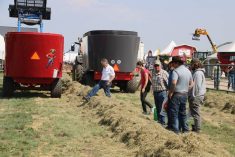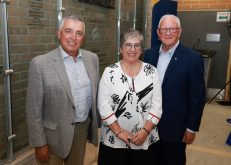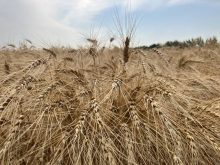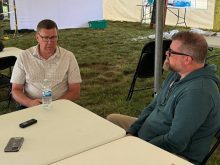CLEARDALE, Alta. – The Poncilius family has already got the word from the bank.
The bank wants its money now.
When the family failed to get the crop off last spring the bank rolled their operating loan forward, thinking there would be money from this year’s harvest.
Nobody could have imagined the 4,000 acres of crop would sit in the field for yet another year.
This summer 2,000 acres of canola seemed to dissolve before their eyes. Canola can’t stand getting its feet wet. In the heavy gumbo flatlands, the crop simply melted away.
Read Also

Supreme Court gives thumbs-up emoji case the thumbs down
Saskatchewan farmer wanted to appeal the court decision that a thumbs-up emoji served as a signature to a grain delivery contract.
Another 2,000 acres of oats remains in the field covered in a mixture of hoar frost and snow.
“We have $200,000 worth of inputs that have to be paid and no crop to pay it with,” said Richard Poncilius, who farms with his son Darrell and son-in-law Kevin Bergma at Cleardale.
The family didn’t buy crop insurance. There is no money to pay off even the smallest loan.
The rows of granaries are full of last year’s almost worthless crop taken off this spring. Every once in a while the local elevator manager will mix one truck load of the low quality grain with a shipment designed to fill about 50 rail cars.
In a few days another bank manager from Calgary will fly up to listen to the family’s diversification plan. If they feed the grain to their pigs, plant more land to grass seed and the government comes up with some sort of aid package and they are eligible for a government loan guarantee, maybe they can carry on for a few more years.
“I can’t see why they’d kick us out the door,” said Richard.
Like the Poncilius family, Ken Hoover also didn’t carry crop insurance. Instead the Cleardale farmer put the equivalent of the premiums into a cow herd each year. Now he is forced to sell the cow herd to pay his bills for crops still out in the field.
“It’s disappointing to have to get rid of a cow herd that’s been years in establishing,” said Hoover.
In his granaries are thousands of bushels of nearly worthless grain. He has been offered 18 cents a bushel.
What worries Hoover and farmers like him is that the pattern will likely repeat next year. It will take weeks for the saturated fields to dry next spring, especially when they’re covered with old swaths, volunteer clovers and weeds.
Two weeks ago, before it froze, water was still running off the fields and into the ditches.
Lots of moisture
Lawrence Smithson seems obsessed about taking his crop off. He is combining standing wheat that is white with heavy frost. What ends up in the hopper is a mixture of two-thirds grain and one-third snow.
The mixture won’t run through the unloading auger so Smithson uses a tree branch to poke it through. It’s a dangerous job standing on the slippery metal crossbeams inches away from the whirling augers below his feet. Smithson has combined 400 acres of wheat this way. Back at the yard, the snow has to be sieved and the grain must be put through the dryer twice.
“I’m not making any money. I’m just getting it out of the way so I can start again next year.”
Smithson has 900 acres of swathed canola, 300 acres of wheat and 700 acres oats of still in the field. He’s about two-thirds done his harvest.
Stan Braim has 200 acres of land in Cleardale that he hasn’t been able to get on for two years. About a third of his crop is still in the field and he hasn’t done any field work.
Braim, one of the organizers of the Cleardale Flood Relief Committee, said although government doesn’t give them any hope farm aid may be coming, it should still keep listening to farmers.
To gather information for the minister of agriculture, Hoover spent a day photographing his neighbors’ crops.
“It’s like taking pictures at a funeral, going around taking pictures of your neighbors’ crops that they’ll never get off,” said Hoover while at the Cleardale store and restaurant he owns.
He had to sell his cattle herd to keep his farm afloat, and has extended credit to the customers at his store.
“How can you say no to your neighbors when they’re in that situation? People are doing what they can to pay the bills.”
















